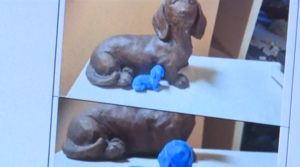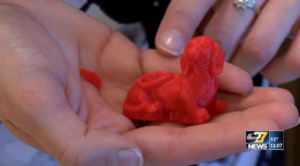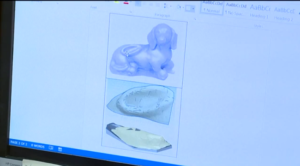Harrisburg University Researchers Working to 3D Print Collagen to Make Safer, Less Expensive Skin Grafts
 Surgeons put a lot of time into performing skin grafts to repair skin that’s been burned, sliced, and otherwise damaged so badly it’s unable to heal itself. The most common type of graft procedure covers the visible wound area using harvested skin from a less visible area. Some synthetic grafts can cause issues after the procedure, such as infection or frequent readjustment. But a team of researchers at the Harrisburg University of Science and Technology (HU) in Pennsylvania believe that their campus 3D printers can change this, and make skin grafts less expensive and safer.
Surgeons put a lot of time into performing skin grafts to repair skin that’s been burned, sliced, and otherwise damaged so badly it’s unable to heal itself. The most common type of graft procedure covers the visible wound area using harvested skin from a less visible area. Some synthetic grafts can cause issues after the procedure, such as infection or frequent readjustment. But a team of researchers at the Harrisburg University of Science and Technology (HU) in Pennsylvania believe that their campus 3D printers can change this, and make skin grafts less expensive and safer.
We’ve seen 3D printing used in wound care before, and now these HU professors and students are using 3D printers to make skin grafts out of human cells that exactly match the areas of damaged skin.
Dr. Glenn Mitchell, an experienced physician and professor of Healthcare Informatics at HU, told Fox 43 News that the goal of the project is to “Map the actual area of your graft and have a 3D printer actually print a biological material called collagen that would fill in your skin graft absolutely perfectly.”While this isn’t the first time we’ve seen collagen used as a 3D printing material, the HU research team is investigating overall methods to make healthcare more affordable, efficient, and safe by using 3D printing technology, and specifically chose skin grafts as their first topic.
In 2016, HU biotechnology professor Dr. Mrunalini Pattarkine received two Presidential Research grants from the university, and is using the second one, which is dedicated to setting up the HU Center for Regenerative Medicine, for two purposes, one of which is to create a 3D printed prototype for contoured skin grafts.
Dr. Pattarkine told ABC 27 News, “Depending on what image you put in the software, it will essentially create that kind of shape.”
Dr. Pattarkine is collaborating with Dr. Mitchell for the grant, and the innovative prototype their research team has produced will be able to provide cost-effective treatment options for the rapid production of contour-matched skin grafts for severe burn patients.
Dr. Mitchell said of today’s skin grafts, “Skin grafts today are either harvested from you and sort of a guess at the shape and thickness of your wound, or it’s some commercial biological materials which are also very generic and sort of gives you problems with fluid collection under them, potential infections.”
- [Image: Fox 43]
- [Image: ABC 27]
- [Image: Fox 43]
The team tested the accuracy of their MakerBot Replicator by 3D printing a small dog statue. Then, students scanned the statue, and gave it a ‘wound,’ which was also scanned so they could figure out its dimensions and depths. They were able to create a graft that perfectly fit the measurements of the dog’s wound.
Once the technology has matured, it could actually help patients heal faster. Dr. Pattarkine said that the ultimate goal is to grow the skin grafts using a patient’s cells, in order to avoid rejection.
Dr. Pattarkine explained, “We’re actually putting the cells in place and just tell them, ‘now you figure out how to become a part of that wound and that body’.”
The other goal is to save hospitals money by making the technology portable and affordable. The researchers used blocks to show that 3D printers could actually fabricate small replicas of themselves. Then, EMTs could have portable scanners, such as EKGs, with them in the ambulance, so they’re able to send a patient’s vital signs to doctors before they even get to the hospital.
Dr. Mitchell said, “Bring down the costs and the power consumption so that it’s very useful in developing countries as well as countries like ours.”
 The project is still in the prototype stage, as the student researchers are working on proving that their techniques of skin graft creation and portable scanners could actually be applied to 3D printers as well.
The project is still in the prototype stage, as the student researchers are working on proving that their techniques of skin graft creation and portable scanners could actually be applied to 3D printers as well.
Dr. Pattarkine stated, “Once the prototype is done, then printing, then clinical trials, then commercialization.”
But hopefully, at least the skin graft process will be ready in the next year or so, so they can start searching for funding.
Dr. Mitchell said, “We’re looking forward to the science and tech world contributing much more directly to the clinical outcome world for patients.”
Let us know your thoughts; join the discussion of this and other 3D printing topics at 3DPrintBoard.com or leave a comment below.
Subscribe to Our Email Newsletter
Stay up-to-date on all the latest news from the 3D printing industry and receive information and offers from third party vendors.
You May Also Like
3D Printing News Briefs, April 13, 2024: Robotics, Orthotics, & Hypersonics
In 3D Printing News Briefs today, we’re focusing first on robotics, as Carnegie Mellon University’s new Robotics Innovation Center will house several community outreach programs, and Ugogo3D is now working...
Rail Giant Alstom Saves $15M with 3D Printing Automation Software 3D Spark
3D Spark has entered into a three-year deal with the rail giant Alstom. Alstom, a transport behemoth with annual revenues of $16 billion, specializes in the manufacture of trains, trams,...
Meltio Expands Global Reach with New Partnerships in the Americas and Europe
Spanish 3D printing manufacturer Meltio has expanded its sales network across the globe. With the addition of three new partners in the United States, Brazil, Argentina, and Italy, Meltio aims...
3D Printing Webinar and Event Roundup: April 7, 2024
Webinars and events in the 3D printing industry are picking back up this week! Sea-Air-Space is coming to Maryland, and SAE International is sponsoring a 3D Systems webinar about 3D...




































